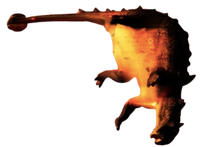
Anodontosaurus is an extinct genus of ankylosaurid dinosaurs within the subfamily Ankylosaurinae. It is known from the entire span of the Late Cretaceous Horseshoe Canyon Formation (mid Late Campanian to "middle" Maastrichtian stage, about 72.8-67 Ma ago) of southern Alberta,Canada. It contains a single species,Anodontosaurus lambei.[1][2]
Discovery[]

Anodontosaurus was named by Charles Mortram Sternberg in 1928, based onholotype CMN 8530, a partially preserved skeleton including the skull,half ring, armor and other postcranialremains.[3] The badly crushed[1]skeleton was collected by Sternberg in 1916 from a Canadian Museum of Nature quarry, 8 miles southwest ofMorrin.[3] It was collected from the upper part of the Lower Horseshoe Canyon Formation (unit 2), dating to the latest Campanian to the earliestMaastrichtian stage of the Late Cretaceous period, about 71-70.2 million years ago.[1][4] The generic name means "toothless lizard" inAncient Greek. It was inspired by the fact that compression damage to the specimen had removed the teeth, at the same time shifting various flat round elements below the skull and on top of the left lower jaw, misleading Sternberg into assuming that large "trituration plates" had replaced the normal dentition.[5] The specific name, lambei, honours Lawrence Morris Lambe, theCanadian geologist and palaeontologistfrom the Geological Survey of Canadawhere the holotype was reposited.[3]
Description[]
Anodontosaurus was a medium-sized ankylosaurid that was quadrupedal, ground-dwelling and herbivorous. Like other ankylosaurs, Anodontosaurus has armor on a majority of the dorsal surfaces of its body. It has a wide, pointed tail club and the end of its armored tail. The skull features postocular caputegulae, which are small polygonal plates of bone that are present on the cranium and are situated to the immediate rear of the eye.
Juvenile specimen[]
In 1986 Coombs examined specimen AMNH 5266, at the time by him referred to Euoplocephalus, and determined that it was a juvenile. Its consists of five vertebral centra, a neural arch, one dorsal and two sacral ribs, the rightischium, the complete right hindlimb, the right pes, an incomplete left pes, and various other fragments. AMNH 5266 was discovered in 1912 at Red Deer River and was collected by Barnum Brown with assistance from Peter Kaisen, George Olsen, and Charles M Sternberg in the sediments from the Horseshoe Canyon Formation.[6]Coombs supported the assertion that this specimen represented a juvenile by citing that that vertebral centra were not fused to their neural arches, and that sacral ribs were likewise not fused to vertebrae and to the ilium. Other morphological characters supporting that this is a juvenile specimen include (a) long bones that feature smooth surfaces, which are not marked by the rugosities characteristic of adult bone; (b) the head of the femur is less spherical in shape and is clearly delimited from the adjacent part of the femoral shaft; (c) the distal ends of the tibia and the fibula are not fused to the astragalus and the calcaneum; and (d) the ungual phalanx of the manus is not widest at the proximal articular end as is observed in adults.
Classification[]
Referred skull NHMUK R4947
Referred skull AMNH 5238
In 1971, Walter Coombs concluded that there was only one species of ankylosaurid during the Campanian age of the Late Cretaceous of North America. He synonymised the species Anodontosaurus lambei, Dyoplosaurus acutosquameus, and Scolosaurus cutleriwith Euoplocephalus tutus. The synonymisation of Anodontosaurus lambei and Euoplocephalus tutus was generally accepted and thus CMN 8530 was assigned to E. tutus. However, following the redescription of Dyoplosaurus as a valid genus by Arbouret al. (2009), Victoria Arbour (2010) argued that Anodontosaurus is a valid taxon as well and distinct from Euoplocephalus. According to her study, published only as an abstract, Anodontosaurus differs from Euoplocephalus in distinctive skull and cervical half ring ornamentation, as well as tail club morphology, including the presence of pointed, triangular knob osteoderms in Anodontosaurus. Furthermore, Arbour (2010) suggested to reassign all Horseshoe Canyon Formation ankylosaurine specimens from Euoplocephalus to Anodontosaurus. The validity of Anodontosaurus was accepted in two subsequent studies. The first, published by Paul Penkalski and William T. Blowsin 2013, re-validated Scolosaurus as well. The second study, by Penkalski (2013), named and described Oohkotokia from Montana on the basis of remains that were originally thought to be referable to Euoplocephalus. Penkalski (2013) performed a small phylogenetic analysis of someankylosaurine specimens. The onlyAnodontosaurus specimen that was included in this analysis was its holotype. Anodontosaurus was placed in a polytomy with the holotype of Euoplocephalus and some specimens that are referred to it, while Oohkotokiawas placed in a clade with Dyoplosaurus, and specimens that are thought to represent either Dyoplosaurus or Scolosaurus. The following cladogramis based on a 2015 phylogenetic analysis of the Ankylosaurinae conducted by Arbour and Currie:
| Ankylosaurinae |
|
Gallery[]





